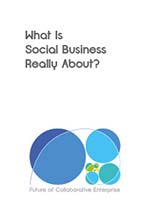This might look like quite an academic title, but heaven knows how little academic I am! I was for a long time interested in AI as a way to use computers to something else than deterministically crunching data, and, as I worked on my last post, was struck by important analogies between key turn points in Artificial Intelligence history and our attempts to define and set up the early stages of the intelligent organization: the so-called Enterprise 2.0.
From processes to networks
Once the first dreams and myths vanished, AI research began to focus on two different subjects: manipulation of abstract symbols and contextual understanding (notably vision and natural language comprehension), and resolution of practical problems. That is, dealing with knowledge and information to take decisions, and ultimately act accordingly. During the late seventies, this field of research took off with the development of expert systems, which computed given information into a large set of rules (the expert knowledge) to trigger practical decisions. The main problem expert systems encountered were the necessity to deal with ever growing massive knowledge databases, and the difficulty to maintain this knowledge current. This approach reminds me a lot the way decisions are taken in our process-driven companies.
To address the enormous amount of necessary computation, researchers began to introduce computational shortcuts such as heuristics to bypass some portions of those huge knowledge trees. It is more than interesting to compare this with our attempts to introduce web 2.0 tools and practices inside business processes to give them more flexibility and efficiency.
Publication, in 1982, of Neural networks and physical systems with emergent collective computational abilities, by John Hopfield, was a breakthrough. The physicist proved that a certain form of networks was able to achieve the same results than rules-based systems. Instead of using databases, Hopfield nets stored it into weighted connections as they learned new patterns of distributed knowledge, and inferred decisions based on the output of the network.
Weights and convergence
The analogy itself between neural networks and a real community-based company is striking, and so are the similarities between the limitations of this approach and some Enterprise 2.0 concerns. Neural networks encountered two big problems: relevancy and convergence (they couldn’t ensure to converge onto the desired pattern, and sophisticated training techniques, such as back-propagation, were necessary to ensure convergence). Social media are facing the very same problems in the enterprise: how could we ensure that communities lead to the right consensus for applicable decisions to be taken? I evoked some possible trails in my last post, and this is a crucial point.
To push the analogy a bit further, the way connections were weighted inside neural networks might give us another path to follow: we might similarly “weight” conversations in social media to facilitate the rise of consensus. Such a system already exists on the Social Web, but is presently mostly a number game, people with more friends and followers are the most listened to, and the most influential. We cannot deal with the limitations of such a system in a professional context and need to look forward for better ways to weight authority and expertise there…
Further advances: micro-processes
The historical analogy stops there, as Artificial Intelligence kept on evolving from these paradigms. Most significantly, from explicit, the logical engines which process information went implicit, completed with a hybrid, “embodied”, approach, where physical captors capture perceptions from the environment: the intelligent agents.
Should, and will, the Enterprise 2.0 follow the same track as AI did? If so, next move would be to get rid of the big business processes we all know, and replace them with micro-processes applicable at individual scale. For instance, the way Japanese coworkers are able to make a consensus emerge from community-based workshops, one of the pre-requisite of Kaizen, rely on their heavy sense of “doing the right thing”. To set up such micro-processes is a radical move from where we are and where the most daring organizations try to go, and would only be possible with intensive education, and a strong commitment from HR and management. Whichever future we might predict to Enterprise 2.0, most underlying concepts are still in their infancy.






Pingback: Liens de la semaine (weekly)